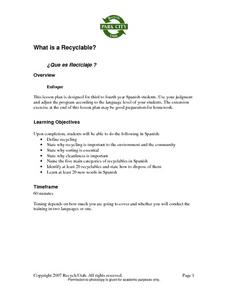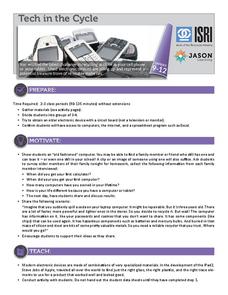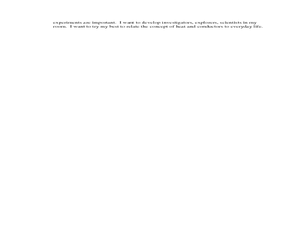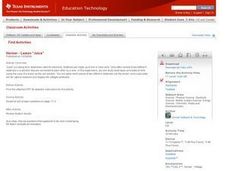Curated OER
Carbon Monoxide and Population Density
Tenth graders investigate the carbon monoxide level at a fixed latitude to determine if there is a relationship to population density. They download data sets and generate a graph, and find locations using the Earth's coordinate system....
Curated OER
Activation Energy
High schoolers investigate activation energy through endothermic and exothermic reactions. In this activation energy lesson plan, students conduct 2 experiments, one is an endothermic reaction and the other is an exothermic reaction....
Curated OER
What is a Recyclable?
Learners explore recycling and how it benefits our environment. In this recycling lesson, students learn to determine if an item is recyclable and sort it into 7 various categories. Learners discover how aluminum, glass, plastic,...
Curated OER
A Special Present
Students conduct an experiment to create a special gift. In this special gift activity, students make a gift for someone using water, Epsom salt, essential oil and food coloring. Students can create a card to go with their present.
Curated OER
Chemical and Physical Changes Lab
In this chemical and physical change worksheet, students conduct a variety of experiments with unknown solutions and make observations. Students determine if the properties of the solutions have changed and if there is...
Curated OER
The Water Cycle
Third graders investigate water formations by conducting an experiment. In this water properties lesson, 3rd graders utilize pie tins, sponges and salt shakers to create an evaporation and saturation experiment. Students collaborate in...
Curated OER
Liquids: Floating and Sinking
Third graders conduct an experiment. In this floating and sinking liquids lesson, 3rd graders discuss density and investigate it using syrup, vegetable oil and colored water. Students observe the results and complete a worksheet.
Curated OER
Types of Marine Debris
Students conduct an experiment. In this marine debris and environment protection lesson plan, students categorize trash into piles, predict whether these trash items will sink, float or be picked up and carried by the wind and then...
Curated OER
Rechargeable Batteries
Students explore how rechargeable batteries work by conducting a series of experiments. In this physics lesson plan, students discuss the benefits of using rechargeable batteries over disposable ones. They build their own battery charger...
Curated OER
Electromagnets
Students conduct a series of experiments on electromagnets. In this physics lesson, students build their own electromagnet and explain how it works. They determine the factors that affect its strength.
Curated OER
Rapid Ecological Assessments
Students conduct an ecological assessment of a small area on school property. They inventory plant and animal life of a sample area and make calculations to determine implications for a larger area.
Curated OER
Balloon Fun
Students conduct an experiment with balloons and skewers. They speculate the reasons for the balloon's reactions to the skewers and write about their observations.
Curated OER
Strange Brew: The Musical Concoctions of Cream
Students distinguish between two styles of music, construct a definition of genius and describe its characteristics, critically analyze and evaluate quotations, and conduct research and present the results.
Curated OER
Conductors and Insulators
Fifth graders explore conductors and insulators. In this science lesson, 5th graders act as electrons moving through a wire. Students break into groups representing conductors and insulators and explore how they work with electrons.
Curated OER
Fall 2004 Midterm Exam #1, Parts A & B
First year physics learners show what they know about electric potential, circuits, power, current, and voltage on this midterm exam. It consists of a multiple choice section, some true or false questions, and two multi-step problems to...
DiscoverE
Let Your Lights Glow
Put those old holiday lights to good use. Individuals use a section of ornamental lights to create electric circuits. If the lights glow, it's a success; otherwise, it's time to try again!
DiscoverE
Oranges and Batteries
Orange you glad you can make circuits using fruit? Young electricians learn about electric circuits and electricity. As part of the instructional activity, they build a circuit with an orange and then with a banana.
US Department of Energy
The Ring Fling Machine
Class members build a machine to demonstrate Lenz's law and help this scientific principle come to life. After building a ring fling machine, instructions for properly operating the machine and a few thought-provoking questions lead to...
Chymist
Esters: An Introduction to Organic Chemistry Reactions
Scratch and sniff an introduction to organic chemical reactions. A creative lesson has individuals study the esters commonly used in scratch-and-sniff stickers and advertisements. Following the lab procedure, scholars create the organic...
Starry Night Education
Comets and Meteors
Comets are also known as dirty snowballs or icy mud balls. With your super scientists, create a model comet nucleus to discover how they are made and take part in a scientific discussion to learn how it behaves.
Jason Learning
Tech in the Cycle
It might not be easy, but it is worth recycling electronics. Small groups determine the percentage of the materials that make up an iPad 2 and display the information in a circle graph. They then research the recycling process for...
International Technology Education Association
Tidy Up Those Sloppy Force Fields!
It is just magnetic. This resource presents the concept of Earth's and another planet's magnetic field and how spacecrafts detect them. Learners study a problem using magnetometers and participate in three experiments to come up with a...
Curated OER
Heat Conductors
Students explore heat conductors. In this lesson on heat, students examine how heat passes through different conductors and how different materials contain heat.
Curated OER
Lemon "Juice"
Middle schoolers explore the concept of electricity in this lesson as they measure the electricity that a lemon gives off. Learners use volt meters to measure the amount of electricity coming from the lemon. Your class will also...

























